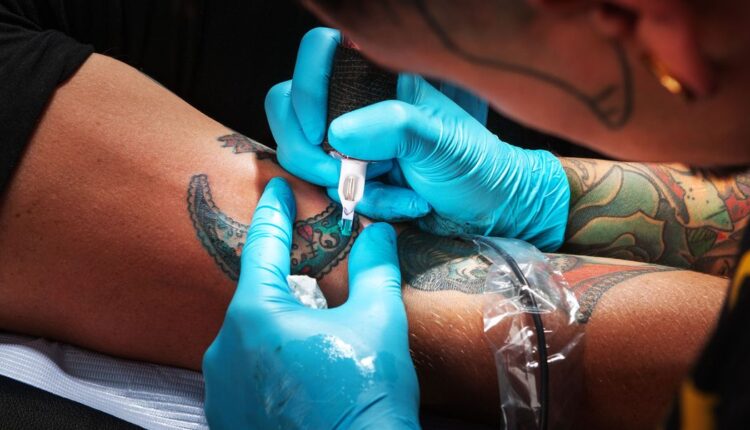GETTING A NEW tattoo is exciting. Getting an infection from your new tattoo is, well, not so exciting.
But it can come with the territory. Of course an infection is possible when you’re getting tons of mini injections in the skin and adding some ink. Even if you go to the fanciest tattoo shop in town, there’s always a chance something could go haywire.
Just because tattoo infections are possible doesn’t mean you need to shy away from booking that appointment for fresh ink. There are many strategies to properly take care of your new tattoos, and plenty of warning signs in case an infection does occur. And, thank you, modern medicine—there are plenty of treatments to help an infection if it does happen.
If you know the signs and act quickly to get help when you see them, you’ll be prepared to mitigate any possible long-term issues.
Infections can start at the appointment, if you’re not careful. It’s important to see a quality artist that uses proper sanitization protocol. There are plenty of red flags to look for when booking an appointment at a new studio (here are a few of them, by the way)— but cleanliness should be a top-tier priority.
Infections are not always the artist’s fault, though. Aftercare is important to ensure the healing wound doesn’t get infected. Your artist should give you detailed instructions on how to properly care for your new ink—be sure to follow those.
Below, dermatologists share how to care for your skin after you get a tattoo, how to tell if your tattoo is infected, and what to do if you think it is.
How Do You Care For A New Tattoo?
The healing process for a tattoo can last between two to four weeks. Aftercare instructions vary among tattoo artists, but they all generally agree with the following strategies. After your appointment, your tattoo will be covered with a bandage or plastic wrapping, which can be removed after about six hours. Wash your tattoo three times per day with unscented antibacterial soap, pat dry with a paper towel, and cover with a thin layer of ointment.
“After getting a tattoo, take care to keep the area clean and moist. An occlusive dressing is often applied to protect the skin while the pigment injection sites heal,” says Lara Devgan, M.D., a top board-certified plastic surgeon in New York City. “Avoid strenuous activities, profuse sweating, and contact with contaminated environmental exposures such as sand, oceans, and debris.”
(How long should you wait to start working out after getting a tattoo? That depends on tattoo placement and a few other key factors. More here.)
Some peeling in the early stages of the healing process is normal, but “never try to pick off the crusting that will typically show up on the surface,” says Viseslav Tonkovic-Capin, M.D., a double board-certified dermatologist based in the Kansas City metro area and editor of DermBoard.org.
Until your tattoo is fully healed, you should also avoid taking baths (showers are perfectly fine), swimming, tanning, scratching the tattoo, and touching the tattoo without washing your hands.
What Are Signs You May Have An Infection?
There are several, each of which may indicate a different kind of infection and thereby a different kind of treatment.
Pus draining
Seeing pus draining from the tattoo site is the most specific sign that your tattoo is infected. Tonkovic-Capin says you’ll definitely want to visit the doctor if this occurs in order to determine if the infection is one that can be treated at home or not.
“You may try to wash it with liquid antibacterial soap and apply over-the-counter double antibiotic ointment three-to-four times a day,” advises Tonkovic-Capin.
Redness and warmth
“If you experience spreading pink discoloration or the feeling of pulsatile heat radiating from around your tattoo, you may have an infection,” says Devgan. Make sure to see a doctor as soon as possible for a topical or oral antibiotics.
You can have swelling and warmth even without infection, says Tonkovic-Capin. But if it persists for more than three days or gets worse, then it is an infection. And you guessed it: See a doctor.
Firm bumps
“Firm bumps, known as granulomas, may signify a specific type of allergic reaction to the dye,” says New York City-based board certified dermatologist, Susan Bard, M.D.
An itchy rash may also occur as a reaction to an allergy to the dyes used in your tattoo (this is most common in red dyes), adds Bard. Either way, see your dermatologist or primary care physician right away.
Fever or Chills
Skin infections can produce similar symptoms to any other kind of infection. One of those common symptoms: a fever.
Body temperature will rise when you’re fighting off an illness like an infection. Because of this, you might feel warm or get a case of the chills— the body’s way of creating heat by rapidly contracting and relaxing the muscles to increase body temperature.
“If you develop a fever, then you should go to the closest emergency room,” says Tonkovic-Capin.
Increased Pain
No shock here. A new tattoo might feel tender for a little while, but if the pain gets worse instead of getting better, that may be sign its infected. If the pain gets past the point of typical discomfort after getting a tattoo, be safe and stop by the doctor’s office so they can assess the situation.
What Are Common Types of Tattoo Infections?
Pseudomonas bacterial or fungal infections
These occur when you tattoo your toes, feet, or ankles.
“Pseudomonas bacterial infections are more common if you wear old, smelly, sweaty sneakers without socks, and fungal infections are more common if you have athlete’s foot/toenail fungus, or walk around barefoot in the gym or public showers, where this fungus likes to lurk,” says Tsippora Shainhouse, M.D., F.A.A.D., a board-certified dermatologist in Beverly Hills, California, at SkinSafe Dermatology and Skin Care.
So what should you look for? Infections typically appear red and are hot, swollen, and have an odor, says Tsippora Shainhouse. Fungal infections can also appear red and have a white scale, like athlete’s foot, he says. He recommends soaking the area with diluted white vinegar and water, along with using a prescription topical antibiotic.
Non-tuberculosis mycobacterium infection
“[This results] from unclean water used in tattoo parlors for washing or diluting ink, or afterwards from exposure in other standing water, like nail salons,” says Shainhouse. “These present as a single red, swollen lump and are usually associated with smaller pink spots or red streaks up the arm (or leg) following the natural lymphatic flow with or without swollen glands in the armpit (or groin).”
If you think you may be suffering from this, see a primary care physician, dermatologist or infectious disease specialist, who can prescribe oral antibiotics.
E.coli skin infections
Tattoos on the butt, groin, or pubic areas are at an increased risk of infection because they come into contact with fecal matter, which contains E. coli bacteria, says Shainhouse. Shainhouse explains these would smell, include pus, and look red and swollen.
Oral antibiotics are necessary right away, so get to the doctor’s office as soon as possible after signs appear.
Viral infections
Shainhouse says your risk of contracting HIV, Hepatitis B, or Hepatitis C are slim, but possible. This can happen if equipment is contaminated and not sterilized after each appointment. “These would not present with acute skin signs, but if you do have other signs/symptoms of Hepatitis or HIV, see your primary care doctor for testing,” says Shainhouse.
What Happens if You Don’t Get Treatment?
Though life-threatening conditions are rare, things can still escalate if you ignore treating your infected tattoo.
“If you don’t care for the infected tattoo, it sometimes may heal on its own, or it may progress with fever, chills, [and] malaise to becoming critically ill, resulting in sepsis that may lead to death,” says Tonkovic-Capin.
If anything strikes you as odd or particularly painful, head to the doctor. It’s important to act as soon as you think something is wrong. “If you don’t care for an infected tattoo, you can risk an undesirable aesthetic appearance of the tattooed area or a disseminated soft tissue infection,” says Devgan. “Tattoos are controlled injuries to the skin, so they represent a break in the skin that must be treated like an open wound, with great care taken to keep it clean.”
Remember: Discomfort at the site of the new ink, itchiness, and scabbing can all be normal after getting a tattoo. But if you have any prolonged symptoms, or any reason to be concerned, it’s best to err on the side of caution and see a doctor ASAP.
How Do I Avoid Getting An Infection?
Ideally, you’ll have a problem-free tattoo. Follow Tonkovic-Capin’s advice for mitigating risk before scheduling your appointment at the tattoo parlor:
Make sure your tattoo artist is licensed. “Ask your tattoo artist how they clean and sterilize the equipment,” says Tonkovic-Capin. “Make sure that they wear gloves during the procedure. After the tattooing is over, your tattoo artist should provide you detailed written instructions on aftercare.”
Refer to the FDA for more information about tattoos and preparing for your next tattoo appointment.
Perri is a New York City-born and -based writer; she holds a bachelor’s in psychology from Columbia University and is also a culinary school graduate of the plant-based Natural Gourmet Institute, which is now the Natural Gourmet Center at the Institute of Culinary Education. Her work has appeared in the New York Post, Men’s Journal, Rolling Stone, Oprah Daily, Insider.com, Architectural Digest, Southern Living, and more. She’s probably seen Dave Matthews Band in your hometown, and she’ll never turn down a bloody mary. Learn more at VeganWhenSober.com.

Vanessa Etienne is the Editorial Fellow at Men’s Health. She has covered health and entertainment for The New York Times, Everyday Health and BET.





Comments are closed.